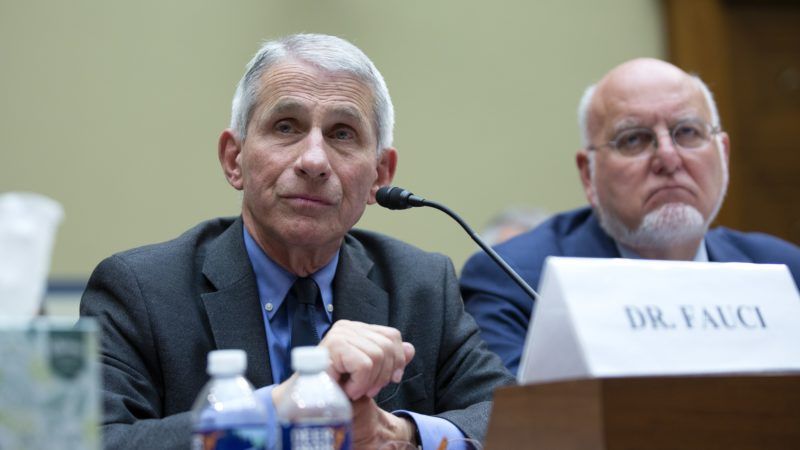Is a 1% Case Fatality Rate for COVID-19 Bad News or Good News?
It depends on how widely the virus spreads, which is difficult to predict.

During congressional testimony yesterday, Anthony Fauci, director of the National Institute of Allergy and Infectious Diseases, estimated that the case fatality rate (CFR) for COVID-19 will prove to be about 1 percent. Is that good news or bad news? It depends on how you look at it.
Fauci's estimate is less than one-third the commonly cited CFR calculated by the World Health Organization and one-tenth the CFR for SARS, another disease caused by a coronavirus. But as he noted, it is 10 times the CFR for the seasonal flu, which is not as readily transmissible. And it is higher than President Donald Trump's guess that the share of infected people who die from COVID-19 will turn out to be "a fraction of 1 percent."
The basic problem is that the total number of cases is unknown, since the vast majority involve mild symptoms that would not necessarily cause people to seek medical attention or testing. The ratio of known deaths to identified cases, which currently yields a CFR of about 3.6 percent, is therefore apt to exaggerate the lethality of the disease. Studies of patients in China and infected cruise ship passengers indicate a substantially lower rate of 2.3 percent, but that is also likely to be an overestimate, since the denominator includes only people who are known to be infected.
Fauci's estimate is close to the CFR in South Korea, which has an aggressive testing program with the capacity to process 20,000 samples a day. So far, more than 200,000 people have been tested there, compared to fewer than 10,000 in the United States, a country with a population more than six times as large. As of yesterday, South Korea had reported 7,755 cases and 60 deaths, which implies a CFR of about 0.8 percent. As in China, the death rate varied widely by age, ranging from 0 percent for patients younger than 30 to 7.2 percent for patients 80 or older. But overall, more than 99 percent of patients survived.
While those odds seem pretty good, even a relatively low CFR can result in many deaths if the infection rate is high. German Chancellor Angela Merkel yesterday warned that 70 percent of her country's population could ultimately be infected by the COVID-19 virus. It's not clear how Merkel arrived at that estimate. But if that worst-case scenario came true, a CFR of 0.8 percent would mean more than 400,000 deaths in Germany. If 70 percent of the U.S. population were infected, the number of deaths would be nearly 2 million.
Is the infection rate likely to be anywhere near that high in the United States? That depends on the effectiveness of measures aimed at curtailing the spread of COVID-19 and developing a vaccine. It also depends on whether COVID-19 follows a seasonal pattern similar to what is seen with the flu. Fauci said that is possible but warned that "we can't proceed under that assumption."
So far epidemic control measures in the U.S. have included isolation of patients, quarantines of potential carriers, cancellation of large-scale public events, school closures, increased reliance on telecommuting, "social distancing," hygienic precautions such as frequent hand washing, and international travel restrictions such as the ban on visitors from China and Iran imposed last month and the ban on visitors from many European countries that Trump announced yesterday. Fauci said Phase 1 clinical trials of about 10 different vaccines should begin within a month or so, but vaccination probably will not begin until "a year to a year and a half" from now.
"We will see more cases, and things will get worse than they are right now," Fauci said. "How much worse [it] will get will depend on our ability to do two things: to contain the influx of people who are infected coming from the outside and the ability to contain and mitigate within our own country."
The 1918 Spanish flu pandemic, which involved a virus with a CFR somewhere between 2 percent and 5 percent, affected about a third of the world population and caused some 50 million deaths, including about 675,000 in the United States. The world population is more than four times as big today as it was then, the U.S. population is about three times as big, and international travel is much more common. But the CFR for COVID-19 appears to be much lower than the CFR for the 1918 pandemic, and disease control measures a century later are much improved.
Fauci declined to predict how many Americans will eventually be infected by the virus. "It is going to be totally dependent upon how we respond to it, so I can't give you a number," he said. "I can't give you a realistic number until we put into [the calculation] the factor of how we respond. If we are complacent and don't do really aggressive containment and mitigation, the number could go way up and [reach] many, many millions."
Show Comments (117)